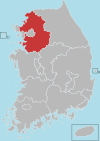|
Guri
Guri (Korean: 구리; lit. Town of Nine Villages[a]; Korean pronunciation: [ku.ɾi]) is a city in Gyeonggi Province, South Korea. It is located immediately to the east of Seoul, in the heart of the Capital Metropolitan Area. The Royal Tombs of the Joseon Dynasty are located in the city. The hill of Achasan is also located here, site of the Baekje-era Achasanseong and numerous hiking trails. It also has pleasant walking paths along Wang-suk-cheon, a small creek separating Guri from Namyangju. The traditional town market in Doldari (Guri's downtown around what used to be a "stone bridge") provides a cheap alternative to department stores. Guri first became a separate city in 1986. Previously, it had been considered part of Yangju from antiquity until 1980, and part of Namyangju from 1980 to 1986. The name "Guri" was first used in 1914, at which time it was a myeon in Yangju. LocationIt lies east-northern area of Gyeonggi province. The mountain of Achasan is to the west and the city of Namyangju to east. The whole area is 33.29 km2 (12.85 sq mi). In fact, Guri used to be bigger but some of the townships were incorporated into Seoul and other cities surrounding Guri. TopographyThe Gwangju mountains are around the north-western area of Guri. They are usually higher than 1000 meters, but to the exact west, there are lower hills. Wamgsil Stream and the Han River flow into city and it has about seventeen tributaries. ClimateGuri has a humid continental climate (Köppen: Dwa), but can be considered a borderline humid subtropical climate (Köppen: Cwa) using the −3 °C (27 °F) isotherm.
TransportationGuri is connected to Seoul via two rail lines (Gyeongui–Jungang Line via Guri station, Gyeongchun Line via Galmae station), as well as numerous city transit and intercity buses. In 2024, the extension of Seoul Subway Line 8 opened for service, bringing additional subway service to Guri.[3] Notable people from Guri
Sister cities
See alsoReferences
Notes
External linksWikimedia Commons has media related to Guri.
|
||||||||||||||||||||||||||||||||||||||||||||||||||||||||||||||||||||||||||||||||||||||||||||||||||||||||||||||||||||||||||||||||||||||||||||||||||||||||




